Built to Last
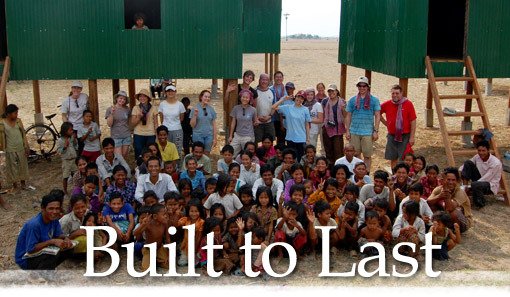
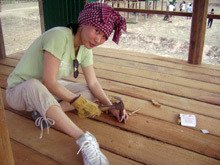
Jennifer Trinh '11 founded the student group SwatCambodia two years ago to provide information about the country's recent past and to raise money and build houses for homeless families there.
In March, six Swarthmore students traveled to Cambodia to be part of an international group of 16 volunteers participating in a house-building project sponsored by the Tabitha Foundation. The trip was the culmination of two years of educational activity and fundraising by the student group SwatCambodia, founded by Jennifer Trinh '11. Both of Trinh's parents were born in Cambodia and, during the summer before her first year at Swarthmore, she visited there for the first time, meeting relatives and learning more about the problems faced by a country that is still recovering from decades of war, genocide, and civil conflict.
The Tabitha Foundation, which has worked in Cambodia since 1994, sponsors integrated development activities at the village level including health care, education, clean water, sanitation, housing, small businesses, and co-operatives. Dave Richter '79 of Issaquah, Wash., who has been involved with the foundation since 2004 on eight house-building trips, was the team leader. Two others from the College - Visiting Language Lecturer Chu-chen Wang and Swarthmore College Bulletin editor Jeffrey Lott - joined the volunteer team at their own expense.
The experience began in Phnom Penh with a daylong orientation to the work of the foundation and to Cambodia's history since the end of World War II, narrated by Janne Ritskes, Tabitha's founder. In addition to visiting the foundation headquarters, the volunteers toured the infamous Khmer Rouge interrogation and torture center at Tuol Sleng, a former high school in the heart of the city, and the Choeung Ek Genocidal Center - better known as the Killing Fields - a few kilometers outside of the capital. The following day, the team headed north to the provincial capital Kompong Thom, where they completed 15 houses in the village of Preah Nankal. Following are student accounts of the trip.

"Looking out over the Cambodian countryside," Jennifer says, "I can hardly express how great it felt that my dream of bringing a team of Swarthmore students to Cambodia had finally come true."
It dawned on me while we were driving to Kompong Thom, looking out over the Cambodian countryside, that I had made the decision to start SwatCambodia two years ago and that so many things had happened along the way to make this trip possible. I can hardly express how great it felt that my dream of bringing a team of Swarthmore students to Cambodia had finally come true - but maybe it's like the feeling of building a house and proudly standing before it after you've finished it.
The first time I went to Cambodia was with my family, including my parents, grandparents, and brother. I was there for a month, visiting family members I never knew existed, visiting places that once had significant meaning for my parents, and, of course, seeing the tourist sights. That trip was also my first experience with a Third-World country. I met cousins who live in wooden shacks with no running water and little or no electricity. I met my great-grandmother as well and had the unique experience of being one of four generations of women simultaneously in one room. That trip led me to discover more about my family's roots and to see first-hand the setting of so many of my parents' sad memories. It was also my inspiration to start SwatCambodia.
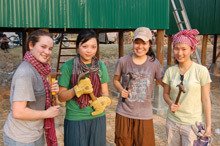
Jennifer (right) with Camila Osorio '12, Ivana Ng '12, and Heidi Wong '10.
In summer 2009, I joined a house-building team with Dave Richter and went to Cambodia again. I learned what a house-building trip is like, so that when other Swarthmore students came with me, I would be prepared to lead them. This second trip was no longer about my past but about the future of several Cambodian families.
This most recent time around was the culminating trip. It was no longer about me, my experience, or my readiness, but about the experiences of the students who went with me and the thoughts they would take away from being in Cambodia. None of us will forget the faces of the Cambodian families as they watched us nail their houses together, hit our thumbs, play with their children, and finally present them with house-warming blankets.
Emotionally, I felt a deep bond with these families, grateful that I had the opportunity to be there. Whenever I spoke my few words of Khmer, people always smiled and tried to communicate with me. This was my spring break - and building these houses helped me remember what life is really about, away from the books and tests. I think we all need a reminder like that once in a while.

Jennifer Trinh '11
Physics with minors in math and peace and conflict studies
Havertown, Pa.

The first day of construction brought the whole community to the scene.
Before this trip, I had the impression that Cambodia is extremely impoverished. Though the village in which we helped build was fairly poor, Phnom Penh and Siem Reap [the city near Angkor Wat, where the students went after completing the house building] looked modern, with markets, nice restaurants, and a fair amount of prosperous local business. If people from other parts of the world could be more aware of what had happened in Cambodia and reach out their helping hands, we can probably help Cambodia achieve an even faster recovery.
The house building was not as exhausting as I had thought. Hammering wasn't an easy job but it was fun, especially working with a group of friends. I was very impressed by the people on the team, who were all very persistent and hardworking. I also had a lot of fun with the kids in the village, who were very sweet and fun-loving. The building project impacted me emotionally. It showed me what it was like to persevere and to work hard with a group of very admirable people and, more important, what it felt like when you were able to reach out and help people.
Cambodia is one of our global neighbors. It has an amazing story and cultural heritage - and adorable and kind people. I learned that making a difference in the world doesn't have to be something spectacular. What we need to do is to take initiative, go out into the world, and make our contributions - big or small.

Eileen Gao '13
Intended math and economics major
Shanghai, China
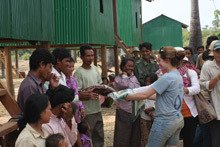
Camila offers housewarming blankets to families during the presentation of the finished houses.
Having been a member of SwatCambodia since the group was formed, not only was I able to help organize the fundraising for the project, but I was also able to see through my own labor those efforts put to use. Cambodia's history of genocide was virtually unknown to me. Having Latin American parents from countries where human rights violations have ravaged populations, I felt a certain connection to Cambodia and an obligation to learn more about the country and its people.
Cambodians are beautiful both on the inside and out. Everywhere we traveled, there was a memorable Cambodian whose life story we learned and to whom we became very attached. They were extremely friendly and welcoming.
The physical labor of building became a challenge that I enjoyed fulfilling. A few blisters and bruises were totally worth the end result. It wasn't until we finished and the community gathered to bless us that I realized the impact of our presence there. Knowing that our work was truly appreciated had me on the verge of tears - but with the biggest smile of joy on my face.

Camila Osorio van Isschot '12
Sociology and educational studies
Silver Spring, Md.
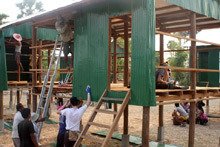
"I'm interested in pursuing architecture," Heidi says. "Seeing buildings progress before my eyes was a nice reminder of what drew me to the field in the first place."
I found the idea of building for those without adequate housing very appealing. I'm interested in pursuing architecture, and it was refreshing to see architecture in this strictly functional way. I spent last summer interning at an architecture firm that largely built houses for wealthy folks. There were huge amounts of time and money spent on minor design details. Hammering nails into crudely cut wooden floor boards all day provided me with a different take on what building a house is about.
It's ironic, because reading Three Cups of Tea, the story of Greg Mortenson's mission to build schools in rural Pakistan, had originally sparked my interest in architecture - in the tangibility of and need for buildings. The opportunity to do some actual construction work in Cambodia, seeing buildings progress before my eyes, was a nice reminder of what drew me to the field in the first place.
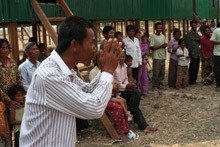
"When we finished the 15 houses, we gathered with all of the families to present them," Heidi says. "I got pretty emotional when one of the men in the village gave a long speech thanking us."
As our vans arrived in the village, there was a group of children waiting at the turnoff, anticipating our arrival. When we drove by them, they ran after us excitedly. Then we pulled up to find the whole village standing together with their hands clapped to their faces.
In Cambodia, when you greet someone, you clap your hands together right beneath your chin, as a sign of respect. Although this is a social norm, I found that this simple motion brought me closer to everyone that I interacted with. When you do this, you acknowledge the other's presence and you bless them.
When we finished the 15 houses, we gathered with all of the families to present them. I got pretty emotional when one of the men in the village gave a long speech thanking us. He spoke in Khmer with his hands clapped together for a long time, and all of us stood around him with our own hands clapped together. Although we didn't understand what he was saying, it was an extremely powerful moment shared among all of us.

Heidi Wong '10
Cognitive science and statistics
Brooklyn, N.Y.
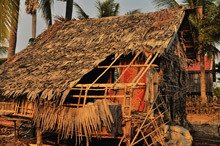
An example of the type of home that the construction replaced.
What really stuck with me was Janne's statement that Cambodians believe that the Khmer Rouge could strike again at any moment. And knowing how the United States - and the United Nations - treated Cambodia during and after the Vietnam War, what could we say to convince them otherwise? Although many people in Cambodia are very poor, they are also unbelievably friendly and generous - yet they carry this weight, the legacy of the Khmer Rouge, on their backs.
The actual building was easier than I expected, but it was the most rewarding experience I've had. These are families whose current homes were mostly made of banana leaves - pretty poor protection, especially during rainy season. It was an amazing experience to be able to help give them sturdier homes, a safe, dry space they can call their own. As I was working alongside members of the families whose houses we were building and playing with their adorable children, I felt an incredible love for this community.
 Ivana Ng '12
Ivana Ng '12
computer science with minors in educational studies and Chinese
Brooklyn, N.Y.
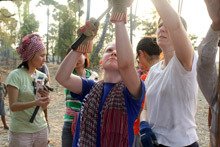
Mary Alice works on one of the houses.
It's one thing to learn about Cambodia and its history from movies and books. It's an entirely different experience to be able to see firsthand the effect that history has had on the Cambodian people and also how organizations like the Tabitha Foundation can help countries recover from a devastating tragedy.
The Cambodian people are honest and work hard to survive. Every person we met had a story about their struggle, yet these struggles did not appear to make them bitter but instead eager to smile and find happiness.
I feel others should know that Cambodia is a truly wonderful country. With a little help, they can rebuild and achieve the same stability they had before the war and the genocide. I believe their story is one that can have a happy ending despite all they have suffered. I learned how little it takes to change a person's life. We spent just two days building, and yet I could tell that we changed the lives of 15 families in just that short span of time.

Mary Alice Upshur '12
Chemistry and French
Newtown, Ct.

Dave Richter '79 of Issaquah, Wash., has been on eight house-building trips to Cambodia with the Tabitha Foundation.
My family has been extremely supportive, and members of SwatCambodia - both those who went and those who, due to time constraints or other issues, were unable to go - have put in as much effort as I could have hoped towards making this trip possible. However, the ones who really need to be thanked are the Swarthmore College faculty, staff, and students, as well as the many kind customers who frequent my parents' small Chinese restaurant, Szechuan Express, and at my aunt and uncle's store, Chestnut Fresh Donuts. The donation jars brought in the majority of our funds. It just goes to show how far a bit of spare change can go - almost 9000 miles! The key figure in all of this, however, has been Dave Richter. Without his guidance and support, we would not have been able to go. Thank you, Dave!

Jennifer Trinh '11
Physics with minors in math and peace and conflict studies
Havertown, Pa.


